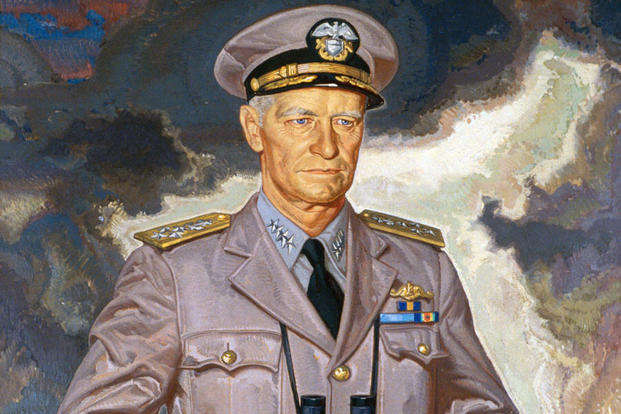Chester W. Nimitz's naval career included a few bobbles on the way to becoming a fleet admiral and war hero. First, he was denied entry to West Point. Shaking off the rejection, the young Texan graduated instead from Annapolis -- but grounded his first ship. Still, he persevered and prospered. Shortly after the Japanese attack on Pearl Harbor, Franklin Delano Roosevelt told him to "get the hell to Pearl and stay there until the war is won."
Nimitz graduated seventh out of 114 midshipmen in his Naval Academy Class of 1905, and his World War II strategy is widely credited with guiding the Allied victory in the Pacific. Focusing not on the mistakes that led to Pearl Harbor but on the enemy's weaknesses, Nimitz coordinated an offensive that brought unconditional surrender from the Japanese.
That effort included the first offensive use of submarines. Nimitz had spent much of his career in and around "pigboats," as they were then known. He arrived at subs in less than glorious circumstances: after a disastrous command on the Decatur, which he was court-martialed for grounding. Nimitz used the shift to revitalize his career, and during his command of the Skipjack/E-1, he was awarded the Silver Lifesaving Medal by the Treasury Department for his rescue of Fireman 2nd Class W.J. Walsh.
Nimitz's many assignments included the first professor of naval science and tactics for the University of California at Berkeley's ROTC unit. After further sea duty, including command of the heavy cruiser Augusta and Battle Division One, he ran the Bureau of Navigation for four years.
FDR plucked Nimitz from the bureau in 1941, designating him commander in chief, Pacific Fleet and Pacific Ocean Areas, in which he served throughout the war. Promoted to the newly created rank of fleet admiral in 1944, Nimitz signed the peace treaty for the U.S. aboard the USS Missouri in Tokyo Bay on Sept. 2, 1945. On Oct. 9 of that year, Nimitz and his naval victory were lauded with a ticker-tape parade down New York City's Fifth Avenue.
The admiral never retired, but instead continued on "duty as directed by the Secretary of the Navy," which included work for the United Nations. He died at age 90 in 1966 and is buried in California's Golden Gate National Cemetery.
Want to Know More About the Military?
Be sure to get the latest news about the U.S. military, as well as critical info about how to join and all the benefits of service. Subscribe to Military.com and receive customized updates delivered straight to your inbox.















